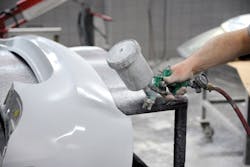Getting properly paid for the work that goes into every aspect of a vehicle’s repair is a critical piece of running a successful body shop. But if estimating systems can’t offer a clear calculation for a specific job, getting paid can take a bit of extra effort—and it often does.
One specific procedure—the preparation of raw, or unprimed, bumper covers—has been missing from estimating systems for years, requiring repairers to manually calculate rates and haggle with insurers over the repair cost. The Database Enhancement Gateway (DEG) is trying to make that problem a thing of the past, and a recent report shows it’s making progress.
“We brought this up as a significant deficiency,” says Arthur Harris, administrator of the DEG.
The DEG has been working with information providers (IPs) for several years on the issue and in 2009 published a matrix that covered the shipped condition of most bumper covers. Since then, some of the major IPs have begun to address raw bumper prep in their estimating systems. In a report release_notesd in September, the DEG outlined how three IPs have responded to its requests for an automated calculation for the work:
Audatex
Because of OEM recommendations, paint manufacturer procedures and a variety of other factors, preparation required for raw bumper covers and other plastic parts is not included in Audatex labor allowances, according to the company’s Database Reference Manual. The manual says the operation can be added manually at 20 percent of the base refinish labor.
However, the company recently added a “Prep Raw Bumper Cover” operation to its bumper cover parts choice box for new and updated vehicles beginning with 2011 models. The operation applies to manufacturers known to supply raw bumper covers and uses the same allowance of 20 percent of the base refinish labor and a 0.3-hour minimum time. There is a possibility that coverage for raw parts other than bumpers will be included in the future.
CCC Information Services
In its Motor Guide to Estimating, CCC includes unprimed bumper preparation as 25 percent of the bumper’s base refinishing time and provides a maximum time allocation of one hour.
The operation includes removal of mold-release agents as outlined by the manufacturer, masking, and application of adhesion promoter. It does not include correction of pre-existing surface imperfections or material costs. The labor value is available as an automated calculation for a dozen makes through an “additional operations” section. CCC is also considering coverage of raw non-bumper parts.
Mitchell International
Mitchell provides no automatic calculation for raw bumper prep, but its Collision Estimating Guide allows 20 percent per refinish hour for plastic, unprimed components. Mitchell users still have to create a manual line entry for labor and materials related to raw bumper prep.
Harris says the changes within Audatex and CCC are encouraging, though some repairers might dispute the formulas. The DEG would like to see more effort from Mitchell on the issue, he says.
Jason Bertellotti, vice president of repair solutions for Mitchell, says the company appreciates the efforts of the DEG, and his team worked extensively with the industry and BASF to develop its formula for raw substrate prep.
“We see automated calculation of raw bumper prep as a future enhancement to our estimating solution that we are in the process of prioritizing against other product enhancements and initiatives,” he says.
The DEG plans to continue working with IPs on the issue, and pushing for the inclusion of other parts.



